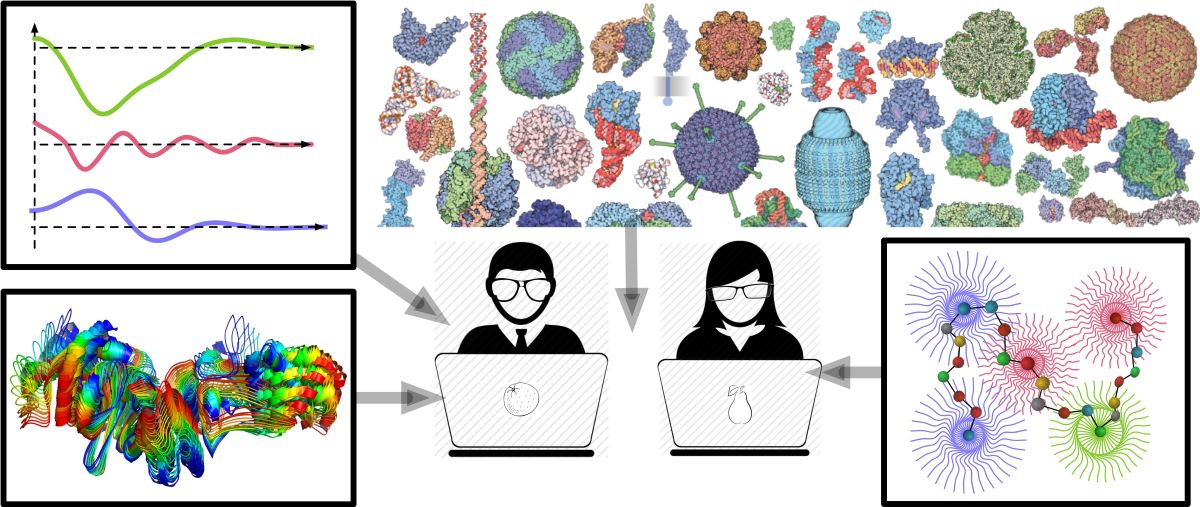AlphaFold2 predictions for the human proteome reveal that the great majority of all human proteins contain intrinsically disordered regions (IDRs) or do not cotnain a folded domain at all. The structure of such proteins must be represented by an ensemble of conformers. However, most experimental techniques provide ensemble-average restraints, which do not contain direct information on width of...
Bacterial infections remain a major public concern due to the accelerated increase in the appearance of antibiotic resistance. Among the different mechanisms used by bacteria to resist to antibiotics, the active efflux plays a major role. In Gram-negative bacteria, this is achieved by tripartite efflux pumps that form a macromolecular assembly spanning both membranes of the cellular wall, the...
Cryogenic electron microscopy (cryo-EM) stands out as a widely utilized technique for elucidating the structures of macromolecular proteins. This method involves capturing projections of protein specimens embedded in thin, amorphous ice, preserving them within the vacuum of an electron microscope. The resulting structure emerges from the averaging of thousands of particle images, revealing...
Cryo-Electron Microscopy (cryo-EM) allows conformational studies of macromolecular complexes in their close-to-native state, essential for understanding their working mechanisms and for structure-based drug development. However, deciphering continuous conformational transitions of macromolecules, through the main cryo-EM processing techniques, Single Particle Analysis (SPA) and cryo-Electron...
Over the past five years, structural biology has undergone a significant progress. The Nobel Prize in Chemistry awarded in 2017 to the developers of cryo-electron microscopy (cryo-EM) marked a milestone, and the rapid progress and widespread adoption of this technique have demonstrated that the precise structural analysis of biomacromolecules is not limited to crystallography or solution...
Life has adapted to extreme conditions on Earth. One of the most striking evidences of adaptation to extreme environments are bacteria that are capable of thriving in a vast temperature range, from below 0° C in glacial waters to above 100° C in deep-sea hydrothermal vents. It is known that the individual molecular components of these organisms, exhibit enhanced stability and resistance to the...
During this seminar, two experimental structural biology projects will be discussed illustrating current challenges and limitations in the field. The first will show how sequence identity may fail in predicting the protein structure and function. The second deals with investigating protein-protein interactions experimentally with the aim of creating small molecule inhibitors that block such...
Integrative structural biology of cell extracts bridges the gap between the high resolution structural characterisation of highly purified, isolated biomolecules and in situ electron tomography. This booming technique combines mass spectrometry (MS)-based proteomics and cryo-electron microscopy (cryo-EM) of fractionated cell extracts to quantitatively and structurally characterise endogenous...
The human IgG2 (hIgG2) isotype is unique in its ability to undergo redox based shuffling of its hinge disulfides. Previous work identified hIgG2 as the optimal isotype for mediating activation (agonism) of multiple tumour necrosis factor receptor superfamily (TNFRSF) members, with the hinge disulfides shown to be critical. CD40 is a co-stimulatory TNFRSF receptor that can be targeted using...
Intrinsically disordered proteins (IDPs) lack clearly defined structure and are therefore highly flexible and easily adaptable to different binding partners. This makes them important players in many biological processes, often with vital regulatory functions. Their dynamic features and broad range of interaction modes, however, render them difficult to study and analyzing their complexes...
Unraveling the mysteries of Intrinsically Disordered Proteins (IDPs) and Regions (IDRs) is one of the greatest challenges in the 21st century. The flexibility of these regions allow proteins to adopt vastly different conformations, allowing them to facilitate the binding and unbinding of vital activation sites. These regions, even in well-studied proteins such as the tumor...
Respiratory complexes located in the internal membranes of our mitochondria are true macromolecular batteries: they couple the flow of electrons through clusters of metals and cofactors with a transfer of protons to create a gradient that provides the energy necessary for the ATP production and therefore to the nourishment of essential life processes. The first complex in the respiratory...
Homorepeats, repetitive sequences inserted in disordered proteins, play fundamental roles in biology and mutations in these low-complexity regions are linked to several neurodegenerative and developmental diseases. Despite their relevance, the structural characterization and modelling of these proteins remain challenging. From an experimental perspective, the severe signal overlap of their NMR...
Understanding the molecular and cellular function of biological molecules requires an accurate perception of their functional assemblies. The term "functional" refers to the actual structure of the bioactive molecule: it includes, but is not limited to, oligomerization, molecular partners, and their multiscale dynamics. Achieving such a functional goal requires a combination of techniques that...

